warning light YAMAHA XVS650A 2001 Owners Manual
[x] Cancel search | Manufacturer: YAMAHA, Model Year: 2001, Model line: XVS650A, Model: YAMAHA XVS650A 2001Pages: 106, PDF Size: 16.06 MB
Page 17 of 106
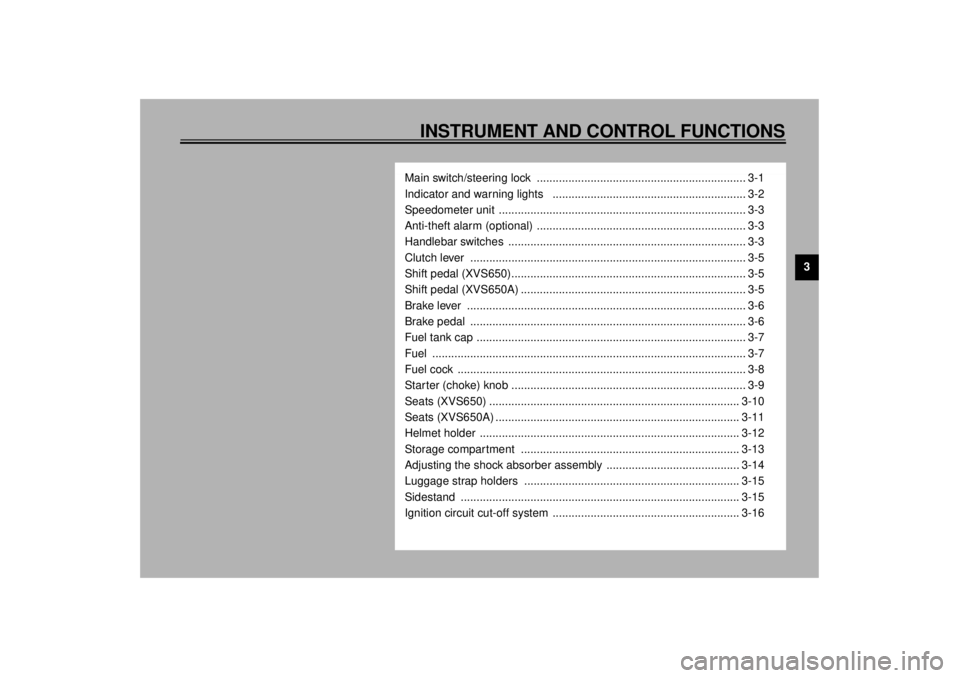
INSTRUMENT AND CONTROL FUNCTIONS
3
Main switch/steering lock .................................................................. 3-1
Indicator and warning lights ............................................................. 3-2
Speedometer unit .............................................................................. 3-3
Anti-theft alarm (optional) .................................................................. 3-3
Handlebar switches ........................................................................... 3-3
Clutch lever ....................................................................................... 3-5
Shift pedal (XVS650).......................................................................... 3-5
Shift pedal (XVS650A) ....................................................................... 3-5
Brake lever ........................................................................................ 3-6
Brake pedal ....................................................................................... 3-6
Fuel tank cap ..................................................................................... 3-7
Fuel ................................................................................................... 3-7
Fuel cock ........................................................................................... 3-8
Starter (choke) knob .......................................................................... 3-9
Seats (XVS650) ............................................................................... 3-10
Seats (XVS650A) ............................................................................. 3-11
Helmet holder .................................................................................. 3-12
Storage compartment ..................................................................... 3-13
Adjusting the shock absorber assembly .......................................... 3-14
Luggage strap holders .................................................................... 3-15
Sidestand ........................................................................................ 3-15
Ignition circuit cut-off system ........................................................... 3-16
E_5bn.book Page 1 Wednesday, October 4, 2000 7:51 PM
Page 18 of 106
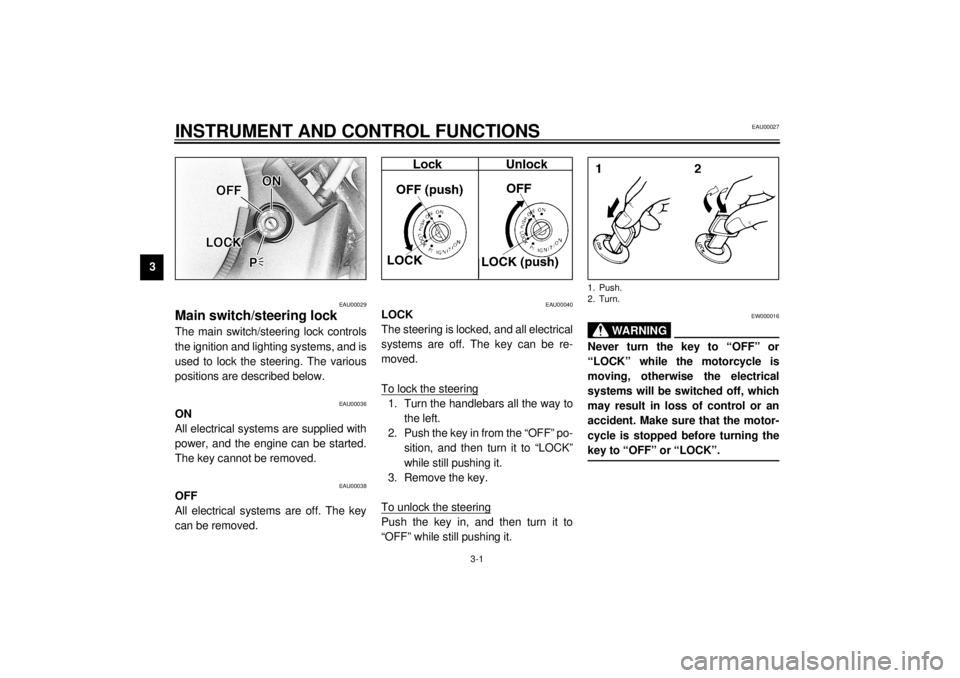
3-1
3
EAU00027
3-INSTRUMENT AND CONTROL FUNCTIONS
EAU00029
Main switch/steering lock The main switch/steering lock controls
the ignition and lighting systems, and is
used to lock the steering. The various
positions are described below.
EAU00036
ON
All electrical systems are supplied with
power, and the engine can be started.
The key cannot be removed.
EAU00038
OFF
All electrical systems are off. The key
can be removed.
EAU00040
LOCK
The steering is locked, and all electrical
systems are off. The key can be re-
moved.
To lock the steering1. Turn the handlebars all the way to
the left.
2. Push the key in from the “OFF” po-
sition, and then turn it to “LOCK”
while still pushing it.
3. Remove the key.
To unlock the steeringPush the key in, and then turn it to
“OFF” while still pushing it.
EW000016
WARNING
@ Never turn the key to “OFF” or
“LOCK” while the motorcycle is
moving, otherwise the electrical
systems will be switched off, which
may result in loss of control or an
accident. Make sure that the motor-
cycle is stopped before turning the
key to “OFF” or “LOCK”. @1. Push.
2. Turn.
E_5bn.book Page 1 Wednesday, October 4, 2000 7:51 PM
Page 19 of 106
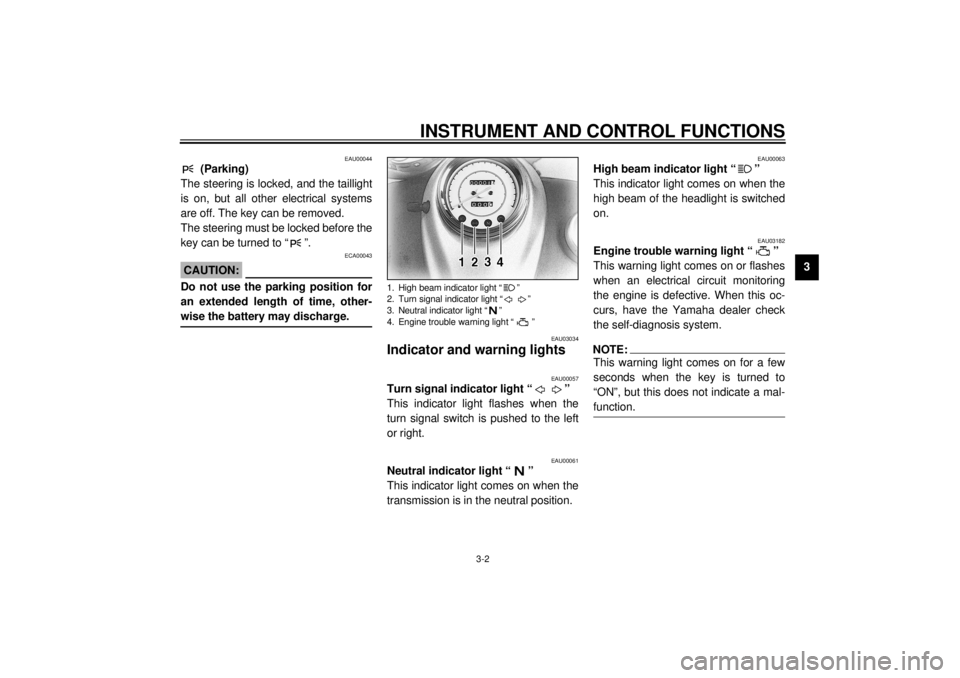
INSTRUMENT AND CONTROL FUNCTIONS
3-2
3
EAU00044
(Parking)
The steering is locked, and the taillight
is on, but all other electrical systems
are off. The key can be removed.
The steering must be locked before the
key can be turned to “ ”.
ECA00043
CAUTION:@ Do not use the parking position for
an extended length of time, other-
wise the battery may discharge. @
EAU03034
Indicator and warning lights
EAU00057
Turn signal indicator light “ ”
This indicator light flashes when the
turn signal switch is pushed to the left
or right.
EAU00061
Neutral indicator light “ ”
This indicator light comes on when the
transmission is in the neutral position.
EAU00063
High beam indicator light “ ”
This indicator light comes on when the
high beam of the headlight is switched
on.
EAU03182
Engine trouble warning light “ ”
This warning light comes on or flashes
when an electrical circuit monitoring
the engine is defective. When this oc-
curs, have the Yamaha dealer check
the self-diagnosis system.NOTE:@ This warning light comes on for a few
seconds when the key is turned to
“ON”, but this does not indicate a mal-
function. @
1. High beam indicator light “ ”
2. Turn signal indicator light “ ”
3. Neutral indicator light “ ”
4. Engine trouble warning light “ ”
E_5bn.book Page 2 Wednesday, October 4, 2000 7:51 PM
Page 37 of 106
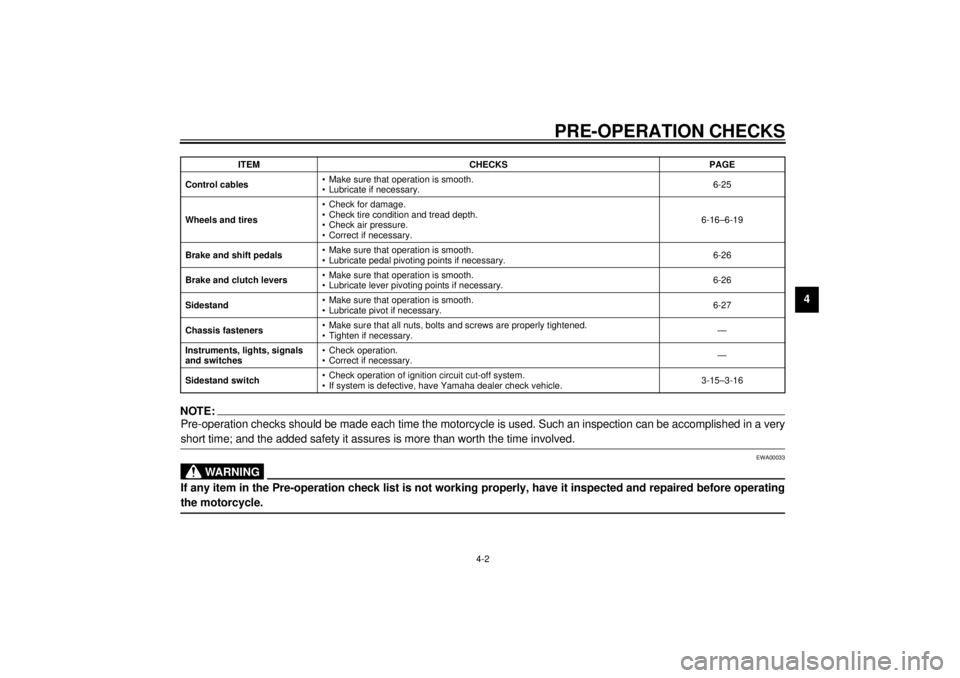
PRE-OPERATION CHECKS
4-2
4
NOTE:@ Pre-operation checks should be made each time the motorcycle is used. Such an inspection can be accomplished in a very
short time; and the added safety it assures is more than worth the time involved. @
EWA00033
WARNING
@ If any item in the Pre-operation check list is not working properly, have it inspected and repaired before operating
the motorcycle. @Control cables• Make sure that operation is smooth.
• Lubricate if necessary.6-25
Wheels and tires• Check for damage.
• Check tire condition and tread depth.
• Check air pressure.
• Correct if necessary.6-16–6-19
Brake and shift pedals• Make sure that operation is smooth.
• Lubricate pedal pivoting points if necessary.6-26
Brake and clutch levers• Make sure that operation is smooth.
• Lubricate lever pivoting points if necessary.6-26
Sidestand• Make sure that operation is smooth.
• Lubricate pivot if necessary.6-27
Chassis fasteners• Make sure that all nuts, bolts and screws are properly tightened.
• Tighten if necessary.—
Instruments, lights, signals
and switches• Check operation.
• Correct if necessary.—
Sidestand switch• Check operation of ignition circuit cut-off system.
• If system is defective, have Yamaha dealer check vehicle.3-15–3-16 ITEM CHECKS PAGE
E_5bn.book Page 2 Wednesday, October 4, 2000 7:51 PM
Page 40 of 106
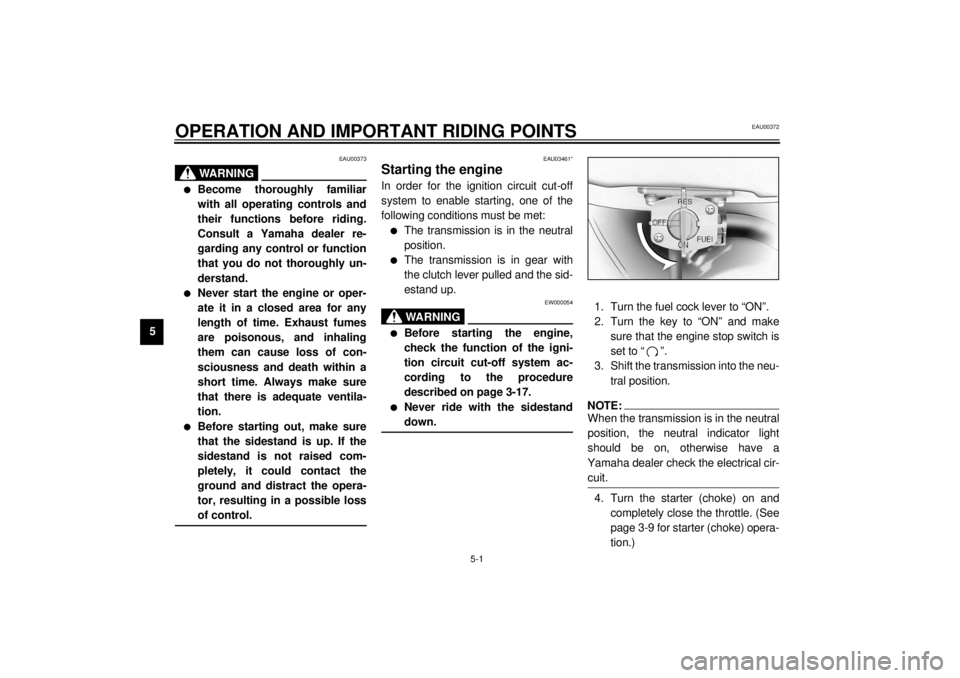
5-1
5
EAU00372
5-OPERATION AND IMPORTANT RIDING POINTS
EAU00373
WARNING
@ l
Become thoroughly familiar
with all operating controls and
their functions before riding.
Consult a Yamaha dealer re-
garding any control or function
that you do not thoroughly un-
derstand.
l
Never start the engine or oper-
ate it in a closed area for any
length of time. Exhaust fumes
are poisonous, and inhaling
them can cause loss of con-
sciousness and death within a
short time. Always make sure
that there is adequate ventila-
tion.
l
Before starting out, make sure
that the sidestand is up. If the
sidestand is not raised com-
pletely, it could contact the
ground and distract the opera-
tor, resulting in a possible loss
of control.
@
EAU03461*
Starting the engine In order for the ignition circuit cut-off
system to enable starting, one of the
following conditions must be met:l
The transmission is in the neutral
position.
l
The transmission is in gear with
the clutch lever pulled and the sid-
estand up.
EW000054
WARNING
@ l
Before starting the engine,
check the function of the igni-
tion circuit cut-off system ac-
cording to the procedure
described on page 3-17.
l
Never ride with the sidestand
down.
@
1. Turn the fuel cock lever to “ON”.
2. Turn the key to “ON” and make
sure that the engine stop switch is
set to “ ”.
3. Shift the transmission into the neu-
tral position.NOTE:@ When the transmission is in the neutral
position, the neutral indicator light
should be on, otherwise have a
Yamaha dealer check the electrical cir-
cuit. @4. Turn the starter (choke) on and
completely close the throttle. (See
page 3-9 for starter (choke) opera-
tion.)
E_5bn.book Page 1 Wednesday, October 4, 2000 7:51 PM
Page 41 of 106
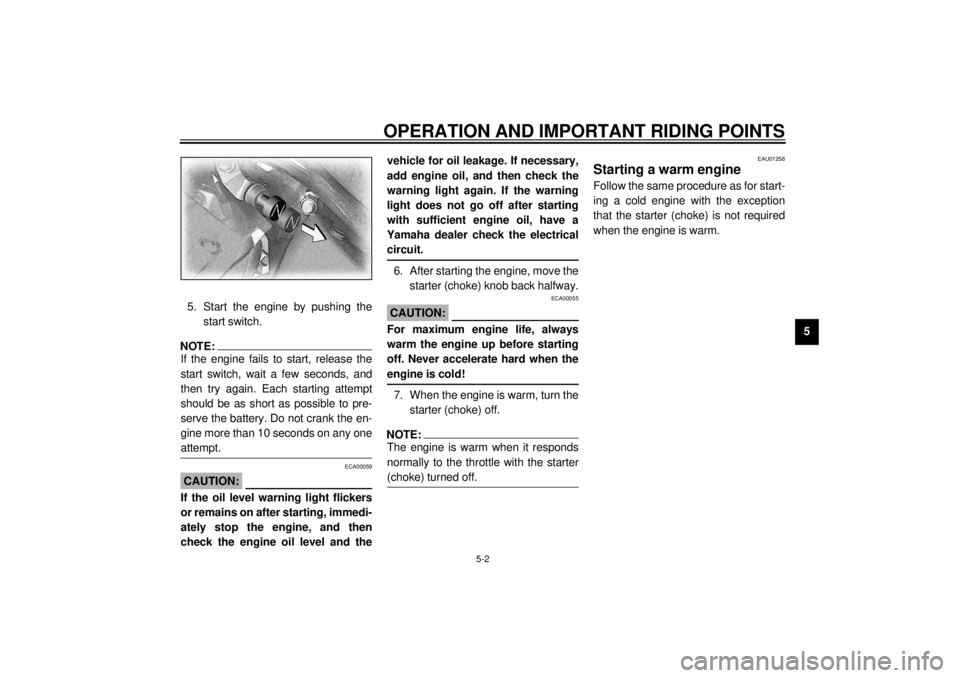
OPERATION AND IMPORTANT RIDING POINTS
5-2
5 5. Start the engine by pushing the
start switch.
NOTE:@ If the engine fails to start, release the
start switch, wait a few seconds, and
then try again. Each starting attempt
should be as short as possible to pre-
serve the battery. Do not crank the en-
gine more than 10 seconds on any one
attempt. @
ECA00059
CAUTION:@ If the oil level warning light flickers
or remains on after starting, immedi-
ately stop the engine, and then
check the engine oil level and thevehicle for oil leakage. If necessary,
add engine oil, and then check the
warning light again. If the warning
light does not go off after starting
with sufficient engine oil, have a
Yamaha dealer check the electrical
circuit.
@6. After starting the engine, move the
starter (choke) knob back halfway.
ECA00055
CAUTION:@ For maximum engine life, always
warm the engine up before starting
off. Never accelerate hard when the
engine is cold! @7. When the engine is warm, turn the
starter (choke) off.NOTE:@ The engine is warm when it responds
normally to the throttle with the starter
(choke) turned off. @
EAU01258
Starting a warm engine Follow the same procedure as for start-
ing a cold engine with the exception
that the starter (choke) is not required
when the engine is warm.
E_5bn.book Page 2 Wednesday, October 4, 2000 7:51 PM
Page 67 of 106
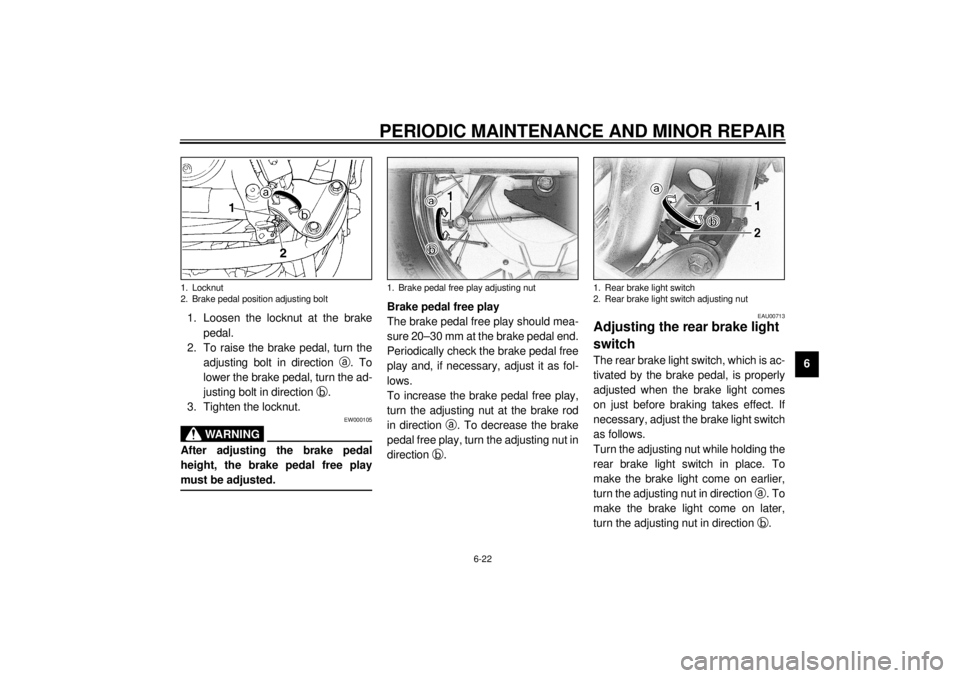
PERIODIC MAINTENANCE AND MINOR REPAIR
6-22
6 1. Loosen the locknut at the brake
pedal.
2. To raise the brake pedal, turn the
adjusting bolt in direction
a. To
lower the brake pedal, turn the ad-
justing bolt in direction
b.
3. Tighten the locknut.
EW000105
WARNING
@ After adjusting the brake pedal
height, the brake pedal free play
must be adjusted. @
Brake pedal free play
The brake pedal free play should mea-
sure 20–30 mm at the brake pedal end.
Periodically check the brake pedal free
play and, if necessary, adjust it as fol-
lows.
To increase the brake pedal free play,
turn the adjusting nut at the brake rod
in direction
a. To decrease the brake
pedal free play, turn the adjusting nut in
direction
b.
EAU00713
Adjusting the rear brake light
switch The rear brake light switch, which is ac-
tivated by the brake pedal, is properly
adjusted when the brake light comes
on just before braking takes effect. If
necessary, adjust the brake light switch
as follows.
Turn the adjusting nut while holding the
rear brake light switch in place. To
make the brake light come on earlier,
turn the adjusting nut in direction
a. To
make the brake light come on later,
turn the adjusting nut in direction
b.
1. Locknut
2. Brake pedal position adjusting bolt
1. Brake pedal free play adjusting nut
1. Rear brake light switch
2. Rear brake light switch adjusting nut
E_5bn.book Page 22 Wednesday, October 4, 2000 7:51 PM
Page 77 of 106

PERIODIC MAINTENANCE AND MINOR REPAIR
6-32
6
EAU00834
Replacing the headlight bulb This motorcycle is equipped with a
quartz bulb headlight. If the headlight
bulb burns out, replace it as follows.
1. Remove the headlight unit by re-
moving the screws.2. Disconnect the headlight coupler,
and then remove the headlight
bulb cover.3. Unhook the headlight bulb holder,
and then remove the defective
bulb.
EW000119
WARNING
@ Headlight bulbs get very hot. There-
fore, keep flammable products away
from a lit headlight bulb, and do not
touch the bulb until it has cooled
down. @4. Place a new bulb into position, and
then secure it with the bulb holder.
1. Screw (´ 2)
1. Headlight coupler
2. Headlight bulb cover
1. Headlight bulb holder
E_5bn.book Page 32 Wednesday, October 4, 2000 7:51 PM
Page 83 of 106

PERIODIC MAINTENANCE AND MINOR REPAIR
6-38
6
EW000103
WARNING
@ After adjusting the brake pedal free
play, check the operation of the
brake light. @
EAU01008
Troubleshooting Although Yamaha motorcycles receive
a thorough inspection before shipment
from the factory, trouble may occur dur-
ing operation. Any problem in the fuel,
compression, or ignition systems, for
example, can cause poor starting and
loss of power.
The following troubleshooting chart
represents a quick and easy procedure
for checking these vital systems your-
self. However, should your motorcycle
require any repair, take it to a Yamaha
dealer, whose skilled technicians have
the necessary tools, experience, and
know-how to service the motorcycle
properly.
Use only genuine Yamaha replace-
ment parts. Imitation parts may look
like Yamaha parts, but they are often
inferior, have a shorter service life and
can lead to expensive repair bills.
E_5bn.book Page 38 Wednesday, October 4, 2000 7:51 PM
Page 96 of 106

SPECIFICATIONS
8-5
8
Bulb voltage, wattage ´ quantity
Headlight 12 V, 60/55 W ´ 1
Auxiliary light 12 V, 4 W ´ 1
Tail/brake light 12 V, 5/21 W ´ 1
Turn signal light 12 V, 21 W ´ 4
Meter lighting 12 V, 1.7 W ´ 1
Neutral indicator light 12 V, 1.7 W ´ 1
High beam indicator light 12 V, 1.7 W ´ 1
Turn signal indicator light 12 V, 1.7 W ´ 1
Engine trouble warning light 12 V, 1.7 W ´ 1
Fuses
Main fuse 30 A
Ignition fuse 10 A
Signaling system fuse 10 A
Headlight fuse 15 A
Carburetor heater fuse 15 A
E_5bn.book Page 5 Wednesday, October 4, 2000 7:51 PM